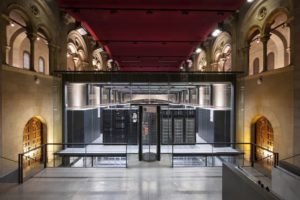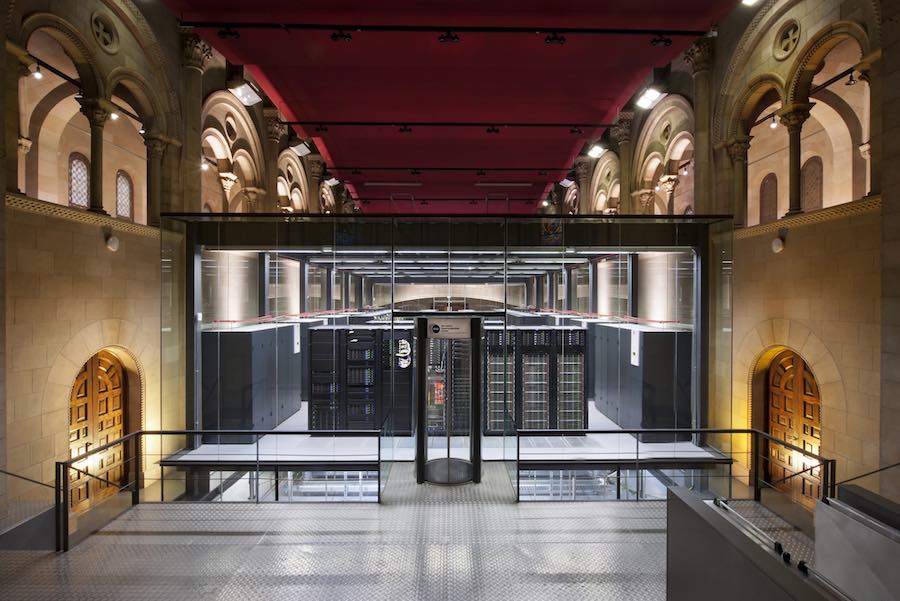 In this video, researchers describe the mission of the Barcelona Supercomputing Center (BSC).
In this video, researchers describe the mission of the Barcelona Supercomputing Center (BSC).
“The Barcelona Supercomputing Center is the national supercomputing centre in Spain. It specializes in high performance computing and manage MareNostrum, one of the most powerful supercomputers in Europe, located in the Torre Girona chapel. BSC is at the service of the international scientific community and of industry that requires HPC resources. The multidisciplinary research team and computational facilities –including MareNostrum– make BSC an international centre of excellence in e-Science. Since its establishment in 2005, BSC has developed an active role in fostering HPC in Spain and Europe as an essential tool for international competitiveness in science and engineering. The center manages the Red Española de Supercomputación (RES), and is a hosting member of the Partnership for Advanced Computing in Europe (PRACE) initiative.”
BSC recently announced plans to build MareNostrum 4, a 13.7 Petaflop supercomputer that will be 12.4 times more powerful than the current MareNostrum 3 system. In a contract valued at almost €30 million, IBM will integrate in one sole machine using its own technologies alongside those of Lenovo, Intel, and Fujitsu.
With this purchase, BSC-CNS has pursued a dual objective: to acquire a general-purpose machine capable of executing all types of scientific and engineering tasks, and to provide itself with clusters built with emerging technologies. These clusters will serve users’ needs and, in turn, will allow the centre to test and analyze the performance of the most recent developments in the field of supercomputing.
To this end, the new machine will have two distinct parts. The general purpose element, provided by Lenovo, will have 48 racks with more than 3,400 nodes with next generation Intel Xeon processors and a central memory of 390 Terabytes. Its peak power will be over 11 Petaflops, which is to say that it will be able to perform more than 11,000 trillion operations per second, ten times more than the MareNostrum3, which was installed between 2012 and 2013. Despite this increase in capacity, it will consume only 30% more power, reaching 1.3 MW/year.
The second element of MareNostrum 4 will be formed of clusters of three different technologies that will be added and updated as they become available. These are technologies currently being developed in the US and Japan to accelerate the arrival of the new generation of pre-exascale supercomputers.
One of these clusters will consist of IBM POWER9 processors and NVIDIA GPUs, which are the same components that IBM and NVIDIA will use for the Summit and Sierra supercomputers that the US Department of Energy has commissioned for the Oak Ridge and Lawrence Livermore National Laboratories. Its computing power will be over 1.5 Petaflops.
The second cluster will be made up of Intel Knights Landing (KNL) and Intel Knights Hill (KNH) processors provided by Fujitsu and Lenovo respectively. They are the same processors that will be inside the Theta and Aurora supercomputers purchased by the US Department of Energy for the Argonne National Laboratory. Its computing power will be in excess of 0.5 Petaflops.
Finally, a third cluster will be formed of 64 bit ARMv8 processors that Fujitsu will provide in a prototype machine, using state-of-the-art technologies from the Japanese Post-K supercomputer. This cluster’s computing power will also be over 0.5 Petaflops.
The goal of the progressive incorporation of these emerging technologies into MareNostrum4 is to enable BSC to operate with what are expected to be some of the most state-of-the-art developments of the coming years and to test if they are suitable for future versions of MareNostrum.




